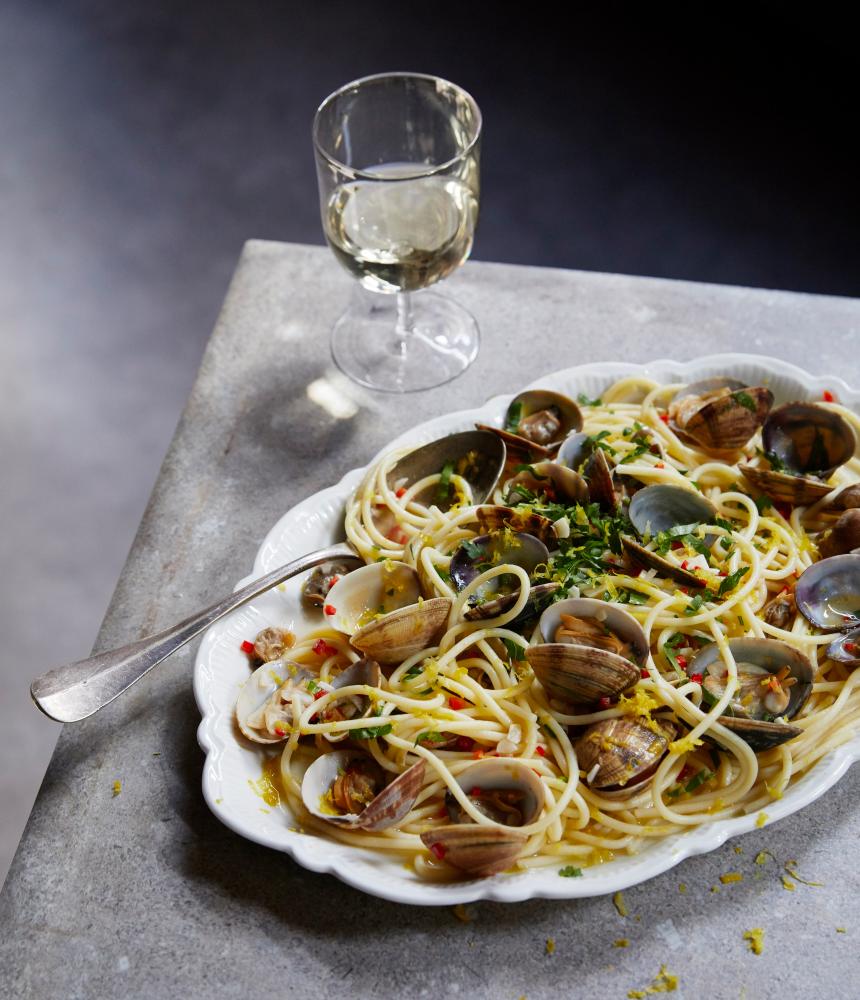
WHY ITALIAN WHITE WINE IS SO FOOD-FRIENDLY
I don’t know how many of you buy wine specifically to drink with food, but the Italians do and we could learn a few lessons from them. If you taste wines such as soave and pinot grigio on their own, you might think they’re a bit bland and boring, but sip a glass with a plate of antipasti or spaghetti carbonara, say, and they spring into life. Italians by and large don’t want wines with overt fruit flavours, too much oak or overly high levels of alcohol, because they overwhelm their fundamentally simple food, which tends to respect both the raw ingredient and the season in which you’re serving it.
Interestingly, I often find that people who are new to wine enjoy pinot grigio for that very reason – it doesn’t have too much flavour. It’s easy to be sniffy about that, and there are some cynically made commercial examples to be sure, but it can also be an enjoyably easy-drinking companion to a simple spring meal, especially if it’s from one of the supermarkets’ premium ranges, which tend to come from Trentino; gavi and gavi di gavi are also popular, I think, for a similar reason – Asda, for example, has a gavi in its Extra Special range for £9.25 that is often, though not currently, on promotion. The other virtue of Italian whites is that they are relatively inexpensive. The regular price of the Verdicchio dei Castelli di Jesi in today’s pick, for instance, is only £7.25 in store at the Co-op (and a little more online).
There’s a growing interest, too, in less well-known Italian grape varieties and wine regions. Aldi recently launched a custoza in its new Unearthed range, while the Co-op has Santa Cristina’s Campogrande Orvieto Classico 2022 for £10.50 (that might sound a fair bit, but it’s sold elsewhere for up to £15). Chardonnay-like grillo from Sicily is also on many supermarket shelves now, though I like the more restrained orchard fruit character of the one in my pick.
True, there are more expensive Italian whites that also have their charms, especially because the alcohol is still moderate – in some instances, as with Tuscan or Sardinian vermentino, for instance, they’re dearer simply because they’re fashionable, while in others, such as with wines made in more mountainous or volcanic regions such as Etna, the cost reflects the more challenging growing conditions and the low yields.
Overall, though, Italy is especially rewarding at this time of year, as well as a good section of a wine list to look to for value, even if you’re not in an Italian restaurant.
Five Italian whites to drink this spring
Unearthed Castellore Custoza 2023 £9.99 Aldi, 12%. Smooth, fresh, creamy and elegant. One for gavi fans. Would be good with crab.
Verdicchio dei Castelli di Jesi Classico 2022 £7.25 Co-op, 13.5%. Fresh-tasting with a herbal edge, verdicchio is one of those wines that goes with anything. It’s often terrific value, too.
Sibiliana Sensale Bio Grillo Sicilia £9.90 Reserve Wines, £9.99 Salisbury Wine Store and The Solent Cellar, 12.5%. Well-priced, appealingly fresh and apple-y organic white that isn’t totally typical of grillo, which is generally more like a chardonnay.
Morisfarms Vermentino Maremma Toscana 2022 £19.50 Jeroboams (or £10.50 a half-bottle), 12.5%. Really classy - smooth, elegant and citrussy. Try with grilled fish or shellfish.
Zuani Collio Bianco 2021 £24.95 (or £22.50 in a case of 12) Lea & Sandeman, 13%. A seductively lush blend of sauvignon, chardonnay, pinot grigio and friulano from Friuli Venezia Giulia in north-east Italy. The perfect showoff spring aperitif, with maybe a few crab-topped crostini.
For more by Fiona Beckett, go to fionabeckett.substack.com